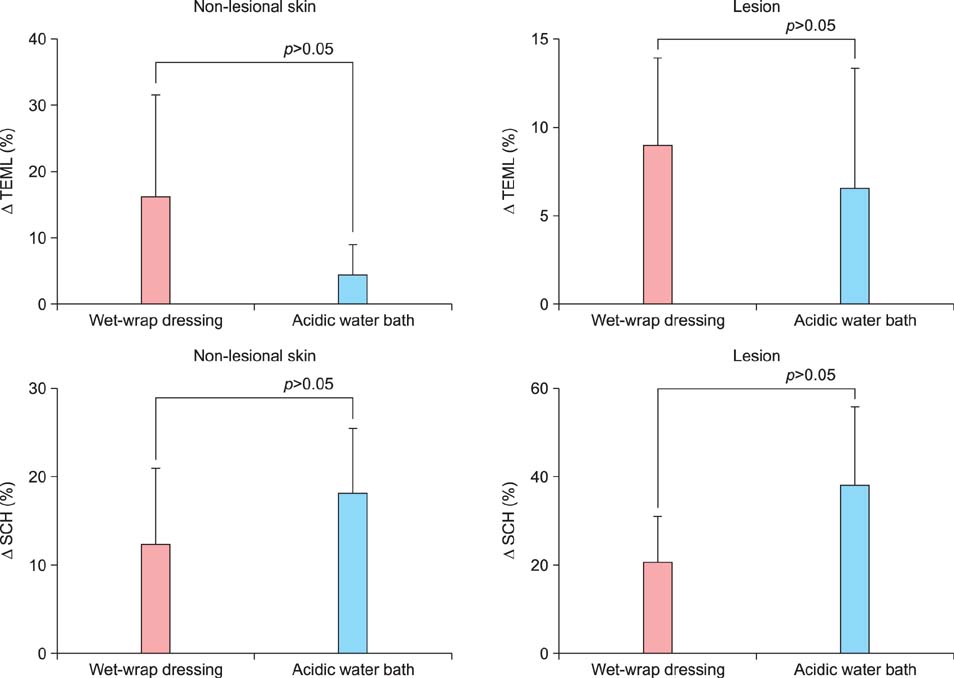Ann Dermatol.
2016 Feb;28(1):126-129. 10.5021/ad.2016.28.1.126.
Acidic Water Bathing Could Be a Safe and Effective Therapeutic Modality for Severe and Refractory Atopic Dermatitis
- Affiliations
-
- 1Department of Dermatology, Yonsei University Wonju College of Medicine, Wonju, Korea. choieh@yonsei.ac.kr
- KMID: 2429500
- DOI: http://doi.org/10.5021/ad.2016.28.1.126
Abstract
- No abstract available.
MeSH Terms
Figure
Cited by 1 articles
-
Application of Topical Acids Improves Atopic Dermatitis in Murine Model by Enhancement of Skin Barrier Functions Regardless of the Origin of Acids
Noo Ri Lee, Hae-Jin Lee, Na Young Yoon, Donghye Kim, Minyoung Jung, Eung Ho Choi
Ann Dermatol. 2016;28(6):690-696. doi: 10.5021/ad.2016.28.6.690.
Reference
-
1. Fluhr JW, Kao J, Jain M, Ahn SK, Feingold KR, Elias PM. Generation of free fatty acids from phospholipids regulates stratum corneum acidification and integrity. J Invest Dermatol. 2001; 117:44–51.
Article2. Hachem JP, Crumrine D, Fluhr J, Brown BE, Feingold KR, Elias PM. pH directly regulates epidermal permeability barrier homeostasis, and stratum corneum integrity/cohesion. J Invest Dermatol. 2003; 121:345–353.
Article3. Devillers AC, de Waard-van der Spek FB, Mulder PG, Oranje AP. Treatment of refractory atopic dermatitis using 'wet-wrap' dressings and diluted corticosteroids: results of standardized treatment in both children and adults. Dermatology. 2002; 204:50–55.
Article4. Fluhr JW, Elias PM. Stratum corneum pH: formation and function of the "acid mantle". Exog Dermatol. 2002; 1:163–175.
Article5. Hachem JP, Roelandt T, Schürer N, Pu X, Fluhr J, Giddelo C, et al. Acute acidification of stratum corneum membrane domains using polyhydroxyl acids improves lipid processing and inhibits degradation of corneodesmosomes. J Invest Dermatol. 2010; 130:500–510.
Article6. Holleran WM, Takagi Y, Uchida Y. Epidermal sphingolipids: metabolism, function, and roles in skin disorders. FEBS Lett. 2006; 580:5456–5466.
Article7. Akiyama H, Yamasaki O, Tada J, Kubota K, Arata J. Antimicrobial effects of acidic hot-spring water on Staphylococcus aureus strains isolated from atopic dermatitis patients. J Dermatol Sci. 2000; 24:112–118.
Article8. Devillers AC, Oranje AP. Efficacy and safety of 'wet-wrap' dressings as an intervention treatment in children with severe and/or refractory atopic dermatitis: a critical review of the literature. Br J Dermatol. 2006; 154:579–585.
Article9. Hatano Y, Man MQ, Uchida Y, Crumrine D, Scharschmidt TC, Kim EG, et al. Maintenance of an acidic stratum corneum prevents emergence of murine atopic dermatitis. J Invest Dermatol. 2009; 129:1824–1835.
Article10. Lee HJ, Yoon NY, Lee NR, Jung M, Kim DH, Choi EH. Topical acidic cream prevents the development of atopic dermatitis- and asthma-like lesions in murine model. Exp Dermatol. 2014; 23:736–741.
Article
- Full Text Links
- Actions
-
Cited
- CITED
-
- Close
- Share
- Similar articles
-
- The pH of water from various sources: an overview for recommendation for patients with atopic dermatitis
- Therapeutic Efficacy of Hot Spring Sea Water Therapy in Atopic Dermatitis: A Pilot Study
- Effect of bathing on atopic dermatitis during the summer season
- Clinical Study with Descresept(R)
- The Clinical Effect of Topical Diphenylcyclopropenone (DPCP) Therapy in the Treatment of Atopic Dermatitis in Children and Adolescents



